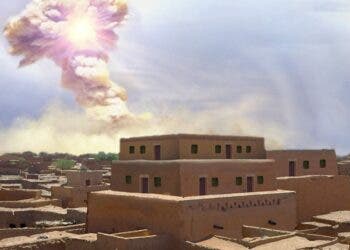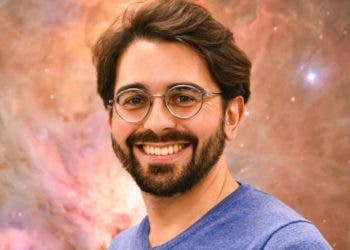
In 1704, Isaac Newton sat down with pen and paper and tried to calculate the end of the world.
He didn’t use a telescope or a laboratory. He used the Bible. Specifically, the prophetic numbers in the Book of Daniel.
More than three centuries later, a few of Newton’s scrawled lines — once tucked into his personal papers — have morphed into a viral myth: that the father of modern physics predicted the apocalypse would arrive in 2060.
But the truth, like Newton himself, is far more complicated.
Newton as a Doomsday Prophet?
We know Newton as the man who discovered gravity, invented calculus, and laid the foundations of modern physics. What fewer people realize is that he also poured decades of his life into alchemy, biblical interpretation, and apocalyptic theology.
In fact, Newton left behind over five million words of religious writing, nearly twice the word count of his published scientific works on math and physics. Another million words of his known writings are on alchemy. He saw no contradiction in this. In his eyes, understanding the universe and understanding God were parts of the same truth-seeking endeavor.
Newton was a devout but fiercely independent Christian who held private religious views that differed significantly from mainstream Anglicanism and Protestantism. He read the Bible like a codebook, especially the prophetic books of Daniel and Revelation. He believed they contained a roadmap of history written in symbolic language. Properly decoded, they could reveal God’s timeline for humankind — and even the future.
His approach was methodical. “So then the time times & half a time are 42 months or 1260 days or three years & an half,” he wrote in one of the letters now housed at the National Library of Israel. “Recconing twelve months to a yeare & 30 days to a month as was done in the Calendar of the primitive year… the period of 1260 days, if dated from the complete conquest of the three kings A.C. 800, will end A.C. 2060.”

To Newton, these “days” were interpreted as years — a common interpretive strategy among Protestant scholars of his day. The year 800 marked the coronation of Charlemagne and the rise of the Holy Roman Empire, which Newton saw as the beginning of an apostate church system (a church that has deviated from core biblical teachings, often replacing them with false doctrines).
The 1,260-year period symbolized the reign of what he called “Babylon”; the corrupt, Trinitarian church that had distorted the original Gospel. 2060, then, would be the date of its fall.
But this wasn’t fire and brimstone. In Newton’s view, 2060 wouldn’t mark the destruction of Earth but the start of a divine transformation. Christ would return and establish “a flourishing and everlasting Kingdom” based on truth and peace. “The true Gospel,” he believed, would finally be preached “openly.”

Newton The Heretic?
Newton never published these ideas during his lifetime. They appeared in scattered letters, marginalia, and private treatises — some composed late in life, when his handwriting had grown visibly frail. He was not being secretive merely out of modesty.
Newton rejected the doctrine of the Trinity (God, Jesus, and the Holy Spirit are one being), a position that placed him in direct theological opposition to the Anglican Church. In contrast, Newton held the belief that God has no equal. Under English law, denying the Trinity could result in civil penalties or worse. His theological writings, which also contain criticisms of both Catholicism and institutional Protestantism, were potentially incendiary and could cost him many privileges, including his position as master of the mint where he made his fortune.
So he kept them hidden.
When Newton died in 1727 without a will, a trove of his private writings — containing both his prophetic calculations and his unorthodox beliefs — passed to distant relatives, and eventually to the aristocratic Portsmouth family. These heirs, deeply loyal to the Anglican Church, kept the documents under wraps. It wasn’t until 1936, when the family auctioned them off to pay debts, that the theological Newton came back into view.
Among the buyers was Abraham Yahuda, a Jerusalem-born scholar who recognized the significance of Newton’s Hebrew-inflected biblical studies. Yahuda eventually donated the papers to the National Library of Israel. There, in the Yahuda Collection, the now-famous 2060 letter finally surfaced in 1969, over 240 years after it was written.
End of Days Prediction or Mere Protest?

It’s easy to imagine Newton, flush with the confidence of his physical theories, trying to forecast the end of time. But that image, which often circulates in sensationalist reports, misrepresents his intent.
In fact, Newton was deeply skeptical of those who predicted the world’s end. “This I mention not to assert when the time of the end shall be,” he wrote in the same 2060 letter, “but to put a stop to the rash conjectures of fancifull men who are frequently predicting the time of the end, & by doing so bring the sacred prophesies into discredit as often as their predictions fail.”
In that case, it’s indeed ironic that Newton would vent his frustration on end-of-daysers by making his own apocalypse prediction. But to be fair to him, he never made these thoughts public. From his writing, we can tell he was exasperated by the stream of apocalyptic prophecies that repeatedly failed and damaged the credibility of scripture. If anything, he wanted to delay the end-time fever. His message was clear: don’t expect the end before 2060. And even then, it might not come.
“… if dated from the complete conquest of the three kings A.C. 800, will end A.C. 2060. It may end later, but I see no reason for its ending sooner,” Newton wrote.
Historian Stephen D. Snobelen, one of the leading scholars of Newton’s religious writings, explains it this way: “Newton was convinced that Christ would return around this date and establish a global Kingdom of peace.” But always the skeptic, Newton’s tone was tentative, not absolute.
“Because he was wary of prophetic date-setting. Newton was worried that the failure of fallible human predictions based on interpretations of divine prophecy would bring the Bible into disrepute. In one of the two times Newton wrote down the 2060 date, he railed against date-setters (see below). Newton may have been aghast if he had known his prediction would be broadcast around the world in the early twenty-first century. His calculations about the 2060 date were private musings made on a scrap of paper not meant for the public. Ironically, the media coverage of the 2060 date has made Newton look like a date-setter. In fact, he opposed this,” Snobelen added.
Science and Religion During Newton’s Times
It’s tempting to separate Newton the rational scientist from Newton the end-of-days theologian. In fact, for many reading about this lesser-known side of Newton, his thoughts will surely come as a surprise. But in his own mind, they were one and the same.
He believed the same God who ordered the stars also shaped human history. The structure of biblical prophecy, to Newton, mirrored the mathematical beauty of celestial motion. He applied the same rigorous logic to both.
In some cases, the overlap was literal. On the same sheet of paper where Newton calculated the apocalypse, he also worked through numerical equations of motion — pure physics beside pure prophecy. As Snobelen has noted, Newton may have seen no barrier between theological and natural knowledge. They were complementary paths to understanding the divine order.
But to modern eyes, this synthesis can feel strange. As 21st-century readers, we live in the shadow of the Enlightenment Newton helped build, one in which science and religion are often siloed, even opposed. That was not Newton’s world.
In the 17th century, natural philosophy embraced magic, alchemy, astronomy, theology, and mathematics. Newton believed he was restoring an ancient, integrated wisdom. The kind of wisdom lost since the early church, corrupted by Rome, and recoverable through the patient decoding of scripture and nature alike — or so Newton believed.
What Will Happen in 2060?
So, Newton never thought the Earth would explode, burn, or vanish in 2060 (although Newton believed there would be wars and cataclysms around the time of the end). Instead, he envisioned a world transformed — corrupt institutions overturned, truth restored, and God’s will made manifest. His version of the apocalypse and interpretation of the Book of Revelation did not involve material destruction, but rather spiritual renewal.
As that year approaches, it’s likely we’ll hear more chatter about Newton’s supposed prophecy. But the real story is richer than that. It’s about a man who bridged two worlds — who believed gravity and God could be found in the same formulas, and who feared not the end of time, but the damage done to the Church by careless speculation.
He may have looked for the end. But he never claimed to know it.
And if 2060 passes like any other year, Newton, at least, won’t be surprised. “Christ comes as a thief in the night,” he wrote, “& it is not for us to know the times & seasons which God hath put into his own breast.”






